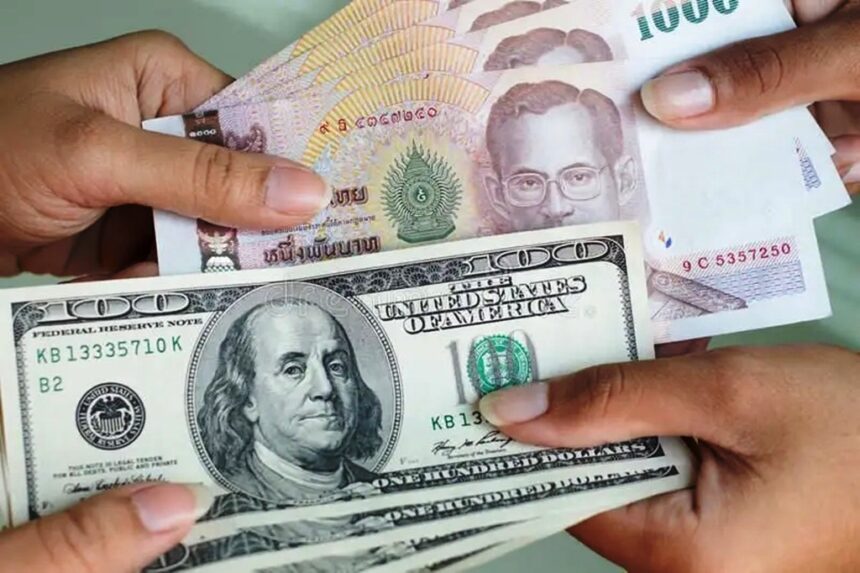BANGKOK – Thailand’s slow recovery from the pandemic has left the Thai baht (THB) at a turning point. Trading around 32.40 against the US dollar this week, the currency has given back much of its strong early 2025 run in the face of global uncertainty.
The slide has stirred memories of the 2022 low near 38 THB per dollar. Looking ahead to 2026, forecasts split sharply. The baht could climb towards a five-year high, possibly dipping below 31 THB per dollar, last seen in late 2019, or it could weaken again and test 35 or beyond.
For expats and investors, the outcome matters a great deal. A firm baht boosts local spending power but hurts returns tied to exports. A softer baht lifts foreign income in baht terms, but raises import and living costs and can scare off investment.
Economists at the Fiscal Policy Office (FPO) expect an average rate of 31.8 THB per dollar in 2026. That would be a 3.2% gain from the projected 2025 average of 32.9, helped by capital inflows and a gentler US dollar. HSBC takes a more guarded view and sees the Thai baht at around 31.0 by mid-2026, with room for a pullback if US policy changes course.
A more bullish camp, such as Traders Union, predicts a stronger move to around 29.55 by year’s end, based on the idea that Thailand will keep posting firm external surpluses. For the Thai baht to reach a five-year high, it would need to break below 31, which would mark its strongest level since 2020 when it averaged 31.25 during a period of very low global interest rates.
On the downside, some models point to a renewed slide towards 34 to 35 if tourism falls short or geopolitical risks flare up again.
This split in outlook highlights how exposed the baht is in a more fractured global system. Thailand’s economy leans heavily on exports, which account for about 60% of GDP, so currency swings feed straight into growth and trade. Where the Thai baht goes in 2026 will depend on a mix of domestic strength and foreign shocks, from US rates to Chinese growth and regional politics.
What Could Push the Baht Higher in 2026
Several forces could support a stronger Thai baht next year. The most talked about is a weaker US dollar. With the Federal Reserve signalling only two rate cuts in 2025, then a pause, the dollar index (DXY) could fall by around 5 to 7% in 2026 as US growth cools to 1.8%, according to IMF forecasts.
When the dollar drops, emerging market currencies often benefit. The baht has a track record of moving with dollar weakness, with a historical beta of 0.8 against the DXY.
Thailand’s own fundamentals also give the baht a base of support. The Bank of Thailand (BOT) expects the current account surplus to reach about 2.5% of GDP in 2026. That is driven by steady demand for electronics and car exports, even if global trade slows a little.
Tourism, a key source of foreign currency, is on track for around 42 million visitors in 2026, about 8% more than this year. That could bring in about 50 billion US dollars, helping to maintain foreign exchange reserves at a comfortable level of around 230 billion dollars.
On top of that, investment flows look encouraging. Foreign direct investment (FDI) in digital and green industries may reach 15 billion dollars, helped by incentives linked to the Eastern Economic Corridor. The FPO notes stronger buying of Thai bonds and shares, with non-resident baht accounts growing by about 12% over the past year. These inflows support the currency and help offset any periods of risk aversion in global markets.
Gold also plays a quiet but important role. Thailand is a major gold trading hub, and the baht often moves with gold demand. With gold prices jumping about 27% in 2025 to more than 3,000 dollars an ounce, speculative money has flowed into baht to fund physical gold purchases. Gold traders in Bangkok report trading volumes up by around 15%, which tends to add extra support for the baht.
At home, the BOT’s policy rate stands at 2.5%, while inflation sits at about 1.2%. That positive real yield keeps Thai assets attractive compared with some peers. The gap between Thai and US bond yields has narrowed to about 150 basis points, which helps limit capital outflows.
Even so, these positive forces do not remove all risks. Domestic politics still cast a shadow. The governing coalition faces internal strains, and any fresh instability could unsettle markets. If the baht strengthens too quickly, the BOT could step in to slow the move, as it did around 2019 when a tax change affecting gold flows caused sharp currency moves.
Why a Baht Slump Cannot Be Ruled Out
While the case for a stronger baht is clear, there is also a realistic path to a weaker currency in 2026. Geopolitical stress points, such as renewed US-China trade tensions or conflict in the Middle East, could drive investors back into the dollar as a haven. In that case, USD/THB could rise towards 35, a level that MUFG sees as feasible if China’s slowdown pulls ASEAN growth below about 4.5%.
Thailand’s reliance on exports makes it especially sensitive. BOT research suggests that a 10% rise in the baht’s value tends to shave around 0.5% off GDP by damaging export competitiveness, particularly against currencies like Vietnam’s dong.
Thailand also faces internal weaknesses. Low inflation sounds positive, but it also reflects weak local spending. Household debt, around 92% of GDP, weighs on consumption and leaves many families with little spare cash. The authorities are also watching illicit financial flows.
The NESDC estimates that about 5 billion dollars a year moves through crypto and undeclared gold channels, which can distort the true level of baht demand and complicate policy. Tougher rules on these flows could surprise markets and dent sentiment in the short term.
Tourism remains another source of risk. Any shock, such as health scares like avian flu or recessions in key source markets, could cut visitor numbers. That would reduce foreign exchange earnings and place pressure on reserves, which might then weaken confidence in the baht. WalletInvestor warns that if US yields move higher again, the baht could fall by 1 to 2% each month for a period, as global investors shift back into dollar assets.
The last five years show how wide the currency’s swings can be. Since 2020, the baht has traded from a strong level near 30.95 per dollar to a weak spot around 38.28 in 2022. A renewed slump in 2026 would echo that 2022 episode, when soaring energy costs pushed Thailand’s fuel import bill up by about 20% and hit growth.
What a Stronger or Weaker Baht Means for Expats
For the roughly 1.5 million expats living in Thailand, from UK and US retirees to European remote workers, the baht’s direction cuts both ways. A stronger baht makes day-to-day life cheaper in local terms for those paid in baht, but more expensive for those bringing in foreign currency. At 31 THB per dollar, a monthly pension of 2,000 dollars converts to 62,000 THB.
That is less than the current 64,800 THB at 32.40 per dollar, so each dollar buys fewer baht. Local prices in baht might not move much, but expats spending foreign income would feel the squeeze. A 20,000 THB Bangkok condo rent, for instance, would cost more in dollar terms at a stronger baht rate.
On the other hand, if the baht weakens to 35 per dollar, that same 2,000 dollars turns into 70,000 THB. That boosts local buying power and makes rents and daily costs feel cheaper in foreign currency terms. The trade-off is that imported goods and some services priced in dollars will go up in baht. Phuket villa rents linked to overseas buyers, for example, could rise by around 8% in foreign currency terms if landlords adjust for a weaker baht.
Remittances work similarly. Expats sending money from Thailand to family abroad lose out when the baht falls. A 10% drop in the Thai baht’s value could cost about 200 dollars a year on transfers of 2,000 dollars a month. Tax is another headache for some. US citizens, for example, may see higher declared income in dollar terms if the baht rises, which can push more earnings into taxable brackets on foreign income.
Across 2025, expat forums have been full of posts about “baht shock”. Some long-term residents report cutting back on non-essentials, such as golf club memberships, while others delay large purchases like property or cars and wait for a better exchange rate.
How Investors Are Positioning for Thai Baht Swings
For investors, the potential baht moves in 2026 bring both risk and chance. A stronger baht usually helps those with Thai baht assets and those with dollar debts. Thai firms with foreign currency loans, such as energy companies, stand to save about 5 to 7% on repayments if the baht rises, according to estimates by the Federation of Thai Industries (FTI).
Local shares can also benefit. If foreign inflows remain strong, analysts see room for the SET Index to rise about 12% to around 1,600, especially in technology and renewable energy stocks.
Foreign direct investment in electric vehicle hubs such as Rayong is another area to watch. Returns of around 15% in Thai baht terms look attractive to long-term investors, especially if the baht holds steady or gains against major currencies. These projects are less sensitive to short-term forex shifts because they focus on multi-year cash flows.
On the flip side, a weaker baht bites into profits for exporters that import components in dollars or euros. A 5% fall in the currency can cut automotive margins by around 3%, a pattern seen in 2022 when the baht’s slide and higher energy costs contributed to a 2% hit to GDP. Portfolio managers also track how currency swings interact with stock market moves.
IMF analysis suggests that, historically, a 1% outperformance of the SET against the S&P 500 has been linked to about a 0.03% depreciation in the baht, as capital flows adjust.
Hedge funds are alert to the chance of higher volatility in 2026, with some eyeing a 2 to 3% volatility premium in baht trading. Many prefer to use forwards and options rather than outright spot positions.
The BOT’s rules on non-resident baht accounts, which cap balances at 300 million THB per investor, limit how aggressive some foreign players can be but still allow fairly active positioning.
For more cautious investors, Thai government bonds yield around 7%, compared with about 4% on US Treasuries. That gap is tempting, yet a sharp baht fall could wipe out the yield advantage through capital losses. Some expats who also invest are looking at Thai baht-hedged exchange-traded funds, which keep exposure to Thai assets while reducing direct currency risk.
In the end, the baht’s path in 2026, whether towards 30 or towards 35 per dollar, will be a major test of Thailand’s economic management and its appeal to global capital.
Many expats are already looking at ways to lock in exchange rates for several months at a time, using simple forwards or multi-currency accounts. Investors are running scenarios for both strong and weak baht outcomes and adjusting their mix of stocks, bonds, cash, and hedges.
As BOT Governor Sethaput Suthiwartnarueput has put it, currencies do not predict the future; they reflect it. In Bangkok’s heat and humidity, the baht’s reaction to the coming year’s shocks and surprises will shape the fortunes of households, retirees, and investors alike.












